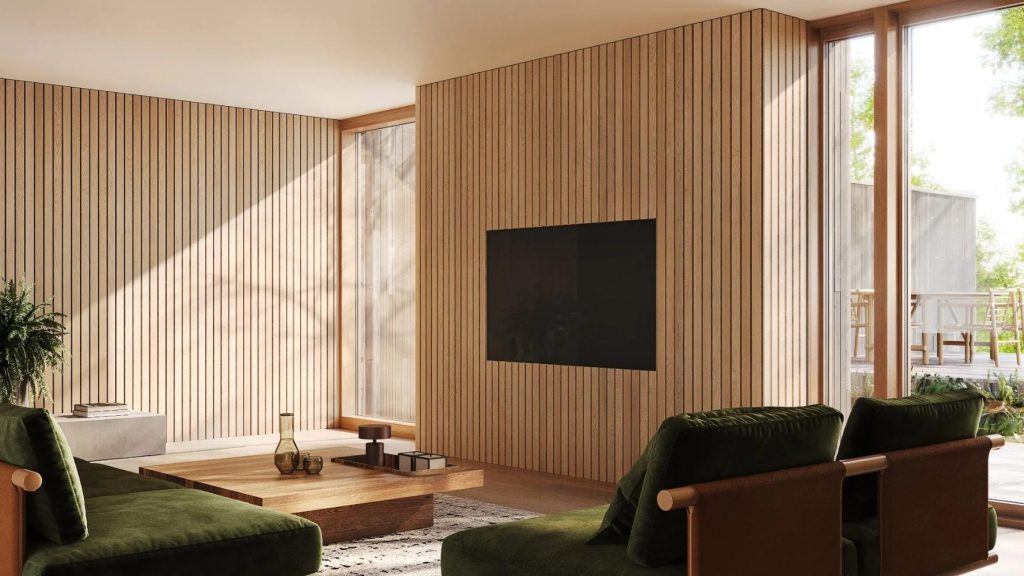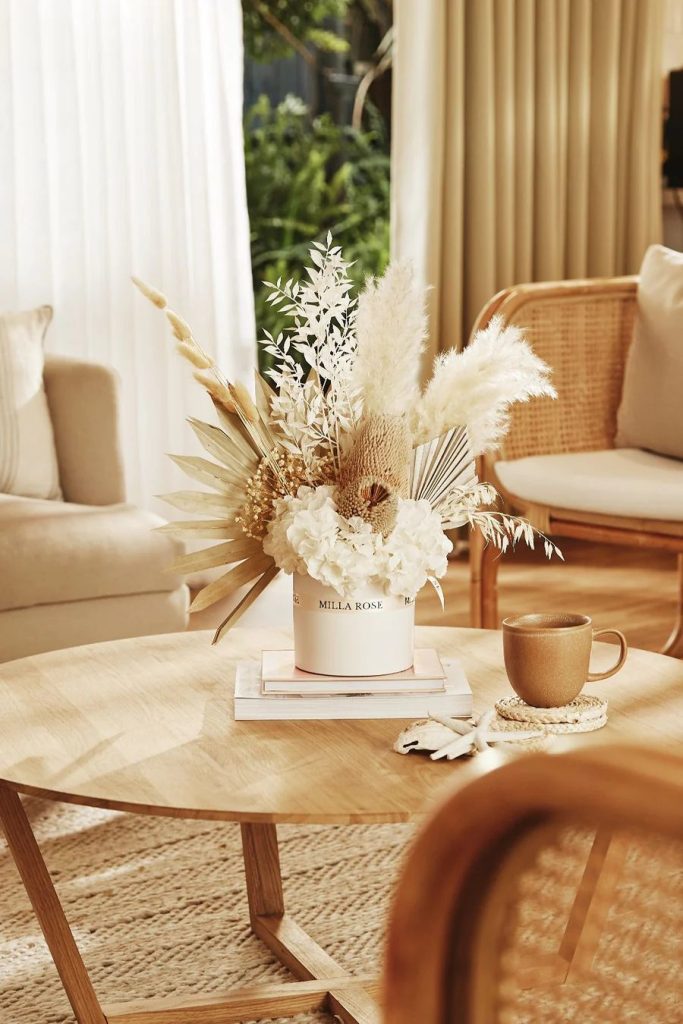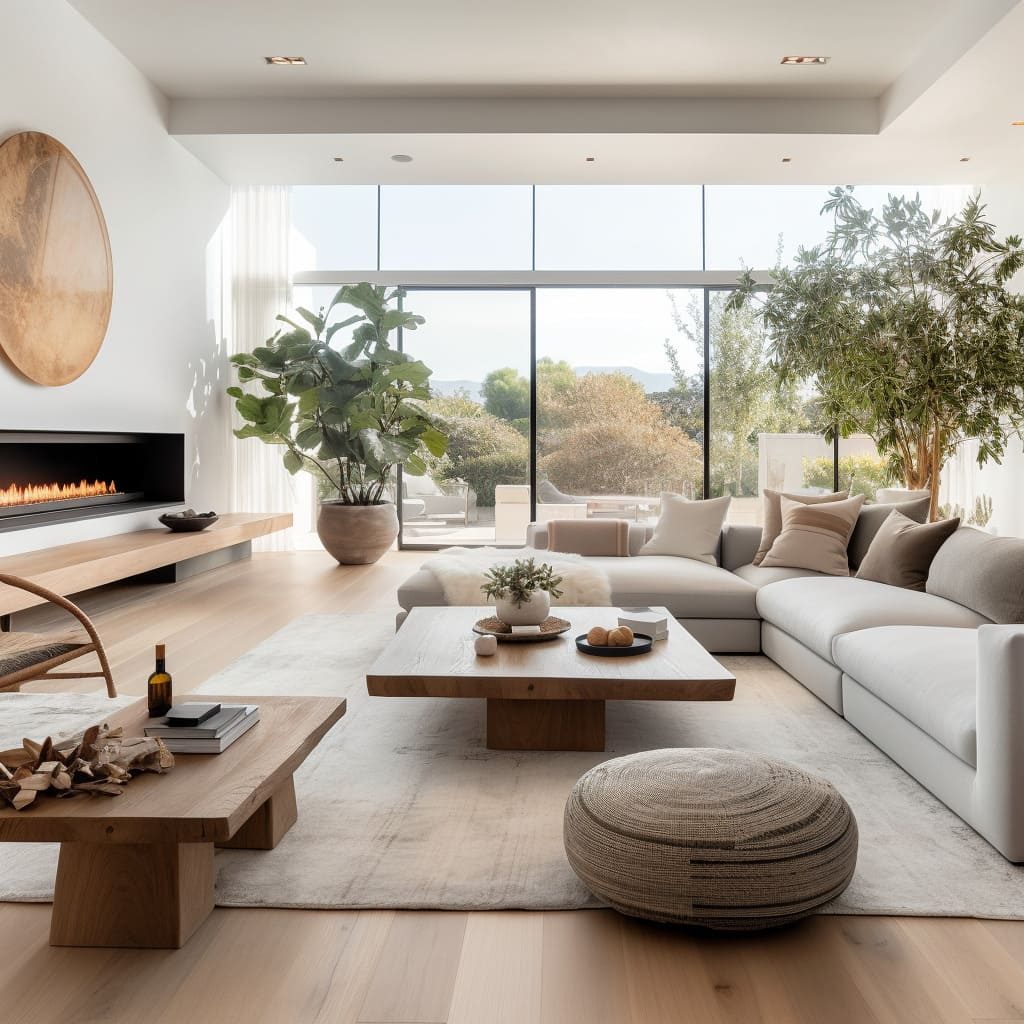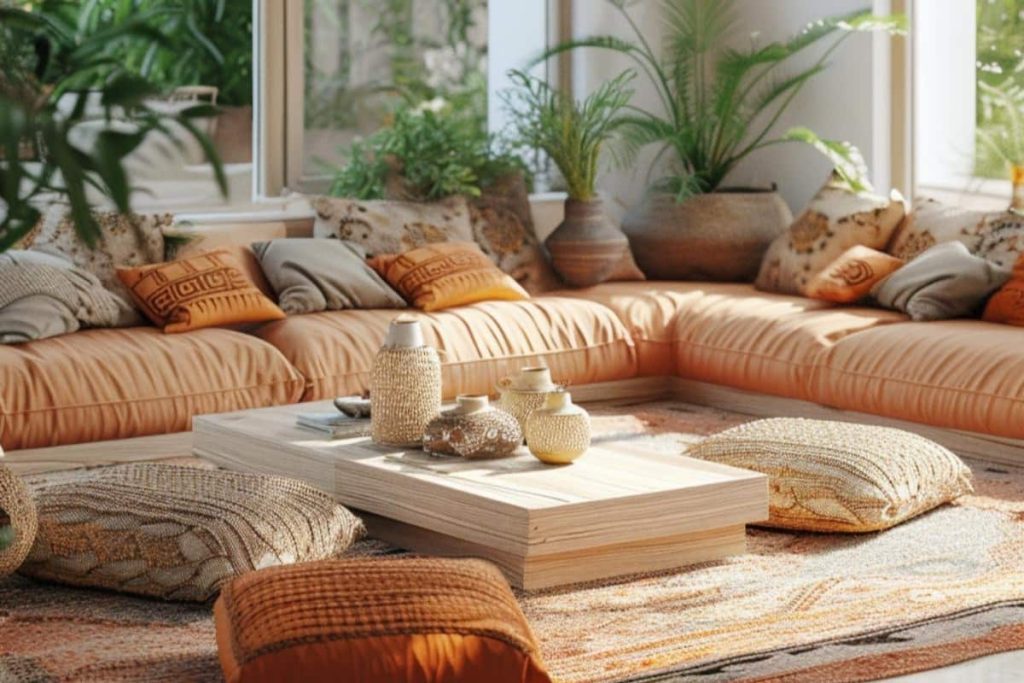In today’s fast-paced digital world, our homes – particularly our living rooms – have become essential sanctuaries where we seek respite from the chaos outside. Creating an earthy living room isn’t just about following the latest design zeitgeist; it’s about crafting a space that grounds us and reconnects us with the natural world.
Whether you’re drawn to the organic textures of raw materials or the ethereal quality of natural light, transforming your living space into an earth-inspired haven can profoundly impact your daily well-being.
This comprehensive guide explores 30 thoughtful ways to infuse your living room with natural elements, from simple botanical additions to more substantial architectural features. Each idea has been carefully curated to help you create a space that not only looks stunning but also feels authentically connected to nature.
Earthy Living Room Ideas
Whether you’re planning a complete renovation or looking for subtle ways to incorporate earthy elements, these ideas will inspire you to create a living room that truly feels like a natural extension of the outdoors.
Natural Material Selection
1. Exposed Wooden Beams

The raw beauty of exposed wooden beams instantly adds rustic charm and architectural interest to any living room. Whether you’re working with authentic salvaged timber or installing faux beams, this dramatic ceiling treatment creates a strong connection to nature while providing a stunning focal point. The organic patterns and rich tones of wood grain contribute to the room’s earthy character.
These structural elements work particularly well in both modern farmhouse and contemporary designs, offering a perfect balance between rustic and refined aesthetics. Consider treating the beams with natural oils rather than heavy stains to preserve their authentic appearance and allow their natural beauty to shine through.
2. Stone Accent Walls

A stone accent wall serves as a powerful statement piece that brings the rugged beauty of the outdoors inside. Whether you choose stacked stone, river rock, or slate, this natural element adds texture and dimensional interest while creating a strong visual anchor for your living space. The varying colors and patterns found in stone can inspire your room’s entire color palette.
When selecting stone for your accent wall, consider the overall style of your space. Smooth, uniform stones create a more contemporary look, while irregular, roughly-textured stones lean towards a more rustic aesthetic. The wall can be further enhanced with strategic lighting to highlight the natural shadows and depth of the stonework.
3. Bamboo Flooring

Bamboo flooring offers an eco-friendly alternative to traditional hardwood while maintaining a natural, organic feel. Its unique grain patterns and warm tones create a sophisticated foundation for any earthy living room design. This sustainable material brings both durability and style to your space.
The versatility of bamboo allows it to complement various design styles, from minimalist to bohemian. Its natural light-to-medium tones can help brighten a room while still maintaining that crucial connection to nature. Consider strand-woven bamboo for increased durability and a more complex, interesting grain pattern.
Color Palette Integration
4. Terra Cotta Accents

The warm, rich hue of terra cotta brings immediate warmth and Mediterranean charm to any living space. This versatile color can be incorporated through painted accent walls, decorative pottery, or textiles, adding depth and character to your earthy design scheme. Terra cotta’s natural pigmentation connects directly to the earth, making it an authentic choice for nature-inspired interiors.
To prevent the color from overwhelming the space, balance terra cotta elements with neutral tones and natural textures. Consider using it in unexpected ways, such as in modern geometric patterns or as a subtle undertone in larger furniture pieces, to create a sophisticated and contemporary take on this traditional earth tone.
5. Forest Green Details

Deep, rich forest green brings the lush vibrancy of woodlands into your living room. This versatile color can be used in various ways, from bold accent walls to plush velvet furniture pieces, creating a sophisticated and natural atmosphere. The depth of forest green provides a perfect backdrop for both light and dark wood elements.
This color choice works exceptionally well when paired with metallic accents in brass or gold, adding a touch of luxury to the earthy scheme. Consider incorporating forest green through different textures and materials to create visual interest while maintaining the natural theme of your space.
6. Chocolate Brown Base

Chocolate brown serves as a rich, grounding base color that epitomizes earthy elegance. This deep, warm tone can be incorporated through larger furniture pieces like sofas or through accent walls, creating a cozy and inviting atmosphere that serves as a perfect foundation for other natural elements. The depth of chocolate brown allows it to act as both a neutral and a statement color.
When working with chocolate brown, consider varying the textures and materials to create visual interest. Leather, velvet, and natural weaves in this rich tone can create a layered look that adds sophistication to your space while maintaining the earthy theme. Pair it with lighter neutrals and metallic accents to prevent the room from feeling too heavy.
7. Sand and Beige Tones

The subtle variety of sand and beige tones brings the calming essence of beaches and deserts into your living space. These versatile neutrals create a warm, welcoming backdrop that can be easily accented with darker earth tones or brighter natural colors. The key is to layer different shades to create depth and avoid a flat, monotonous look.
Incorporate these colors through textured wallpapers, natural fiber rugs, or plush upholstery. Consider using different materials like linen, cotton, and wool in varying sandy shades to create a rich, nuanced palette that maintains visual interest while providing a serene atmosphere.
Texture and Pattern Elements
8. Natural Fiber Rugs

Jute, sisal, and seagrass rugs bring authentic natural texture to your floor while providing durability and style. These natural fiber rugs add immediate warmth and organic pattern to your space, creating a perfect foundation for your earthy living room design. Their neutral tones and varied textures work well with any color scheme while maintaining the connection to natural elements.
Consider layering these rugs with smaller, softer pieces for added comfort and visual interest. The natural variations in color and texture that occur in these materials add to their charm and authenticity, creating a truly organic feel in your space.
9. Woven Baskets and Storage

Incorporating woven baskets as both storage solutions and decorative elements adds functional texture to your space while maintaining the natural theme. These versatile pieces can be used to store blankets, magazines, or toys while serving as artistic elements that contribute to the room’s earthy aesthetic. The organic patterns and textures of handwoven baskets bring authentic craftsmanship to your design.
Display baskets in varying sizes and weaving patterns to create visual interest. Consider mounting some on walls as art pieces or grouping them together to create a striking visual display. The natural variations in color and texture add depth to your design while providing practical storage solutions.
10. Textured Wall Treatments

Beyond traditional paint, consider textured wall treatments like grasscloth wallpaper, textured plaster, or natural fiber wall coverings. These elements add depth and interest to your walls while maintaining the earthy aesthetic. The subtle variations in texture create a sophisticated backdrop that enhances other natural elements in your space.
These wall treatments can be used on all walls for a cohesive look or as an accent to create focal points within the room. The natural variations in texture catch light differently throughout the day, adding dynamic interest to your space while maintaining a connection to organic materials.
Botanical Elements
11. Living Plant Walls

Transform a blank wall into a living tapestry with a vertical garden or plant wall. This dramatic feature brings literal life to your space while improving air quality and acoustic properties. The varying shades of green and different leaf textures create a dynamic, ever-changing artwork that serves as a stunning focal point.
Consider using a mix of trailing and upright plants to create depth and interest. Choose plants that thrive in indoor conditions and complement each other in terms of care requirements. The living wall can be as simple or complex as you desire, from a few mounted planters to a full floor-to-ceiling installation.
12. Large Indoor Trees

Incorporate statement-making indoor trees to add height, drama, and natural beauty to your living room. Species like Fiddle Leaf Fig, Olive trees, or Bird of Paradise create instant impact while helping to purify the air and add life to your space. Their organic shapes and varying heights help to break up straight lines and add visual interest.
Position trees in corners or near windows where they can thrive and create natural focal points. Consider using woven baskets or earthenware pots as planters to enhance the natural theme. The movement of leaves and play of light through branches adds a dynamic element to your room’s design.
Related Guide: 20 Creative Earthy Bathroom Ideas
13. Dried Botanical Arrangements

Bring the beauty of preserved nature indoors with thoughtfully arranged dried botanicals. Pampas grass, dried flowers, and preserved branches create long-lasting natural displays that add texture and organic shapes to your space. These arrangements provide a low-maintenance alternative to live plants while maintaining the connection to nature.
Mix different types of dried materials to create interesting compositions. Consider using large-scale arrangements for dramatic impact or smaller groupings for subtle natural touches throughout the space. The neutral colors of dried botanicals complement any earth-toned palette while adding sophisticated texture.
Furniture Selection
14. Reclaimed Wood Furniture

Incorporate furniture pieces crafted from reclaimed wood to add character and history to your space. Each piece tells a story through its weathered patina and unique markings, creating instant charm and authenticity in your earthy living room. The natural imperfections and varied tones of reclaimed wood add depth and interest to your design.
Choose pieces that showcase the wood’s natural character, such as coffee tables with live edges or consoles with visible grain patterns. Mix different wood tones to create a collected-over-time feel that adds warmth and personality to your space.
15. Organic Shape Seating

Move away from rigid, geometric furniture by incorporating seating with organic, flowing lines. Curved sofas, rounded armchairs, and sculptural accent chairs add softness and natural movement to your space. These pieces create a more relaxed, inviting atmosphere while echoing shapes found in nature.
Consider upholstering these pieces in natural fabrics like linen or cotton in earth-toned colors to enhance their organic appeal. The combination of flowing lines and natural materials creates a harmonious blend that supports your earthy design theme.
Lighting Elements
16. Natural Light Enhancement

Maximize natural light in your living room by keeping window treatments minimal and strategically placing mirrors to reflect light throughout the space. Consider using sheer, natural fiber curtains that filter light beautifully while maintaining privacy. The play of natural light throughout the day adds warmth and life to your earthy design.
Use reflective surfaces thoughtfully to bounce light into darker corners and create a brighter, more open feeling space. Position furniture to take advantage of natural light patterns and consider how different materials and textures interact with changing light throughout the day.
17. Woven Light Fixtures

Incorporate pendant lights and chandeliers made from natural materials like rattan, bamboo, or woven grasses. These fixtures add organic texture and create beautiful shadow patterns when lit, adding another layer of natural interest to your space. The warm glow filtered through natural materials creates an inviting atmosphere.
Choose fixtures that complement your room’s scale and style while maintaining the earthy theme. Consider mixing different styles of woven lights to create visual interest and provide varied lighting effects throughout your space.
Decorative Elements
18. Handcrafted Pottery

Incorporate artisanal ceramics and pottery pieces to add authentic, earthy character to your space. From large floor vases to small decorative bowls, handcrafted pottery brings organic shapes and natural textures that enhance the room’s connection to the earth. The imperfect nature of handmade pieces adds personality and warmth to your design.
Display pottery in thoughtful groupings, varying heights and sizes to create visual interest. Choose pieces in earth tones like terracotta, slate, and sandy beiges to maintain the natural color palette while adding depth through different glazes and finishes. Consider mixing both functional and purely decorative pieces to create a curated collection that tells a story.
19. Natural Stone Accessories

Incorporate decorative elements made from natural stones such as agate, marble, and onyx. These pieces add geological interest and luxury to your earthy design through bookends, coasters, or decorative objects. The unique patterns and colors found in natural stone provide sophisticated accent pieces that complement other natural elements.
Mix different types of stones to create interest while maintaining a cohesive look through color coordination. Consider how light interacts with translucent stones and position them to take advantage of natural or artificial lighting. These elements can serve as both functional accessories and artistic focal points.
20. Tribal and Indigenous Art

Honor traditional craftsmanship by incorporating tribal and indigenous artwork into your design. These pieces bring cultural richness and authentic earthiness through their use of natural materials and organic patterns. From woven wall hangings to carved wooden sculptures, these elements add depth and story to your space.
Choose pieces that resonate with your personal style while respecting their cultural significance. Consider creating a gallery wall mixing different mediums and origins, or use a single statement piece as a focal point. The natural materials and traditional techniques used in these artworks strengthen the connection to earth and human craftsmanship.
Architectural Features
21. Natural Ventilation

Design your living room to maximize natural airflow through thoughtful window placement and ceiling fans made from natural materials. This approach not only reduces energy consumption but also creates a stronger connection to the outdoor environment. The movement of air through the space adds a dynamic element to your earthy design.
Consider installing operable windows at different heights to create cross ventilation and incorporate traditional architectural elements like transom windows. Choose ceiling fans with wooden blades or natural fiber weaving to maintain the organic aesthetic while providing functional air movement.
22. Organic Room Dividers

Create distinct zones within your living space using natural room dividers such as bamboo screens, macramé hangings, or living plant walls. These elements add visual interest while maintaining an open feel and connection to nature. The transparent or semi-transparent nature of these dividers allows light to flow through while defining separate areas.
Experiment with different heights and arrangements to create the desired level of privacy and separation. Consider how these dividers can be moved or adjusted to accommodate different needs while maintaining their decorative appeal. The natural materials and organic patterns contribute to the overall earthy aesthetic.
Textile Integration
23. Hand-Loomed Textiles

Incorporate hand-loomed textiles through throws, pillows, and wall hangings to add warmth and artisanal character to your space. These pieces bring rich textures and natural fibers that enhance the earthy feeling while providing comfort and visual interest. The imperfections and unique patterns in hand-loomed items add authenticity to your design.
Layer different textures and patterns while maintaining a cohesive color palette drawn from nature. Consider mixing weights and weaves to create depth and seasonal versatility. The handcrafted nature of these textiles adds a human touch that connects to traditional craftsmanship.
Related Guide: 25 Stunning Sage Green Kitchen Ideas
24. Natural Fiber Curtains

Choose window treatments made from natural materials like linen, hemp, or bamboo to filter light beautifully while maintaining privacy. These materials add organic texture and movement to your walls while contributing to the overall earthy aesthetic. The way natural fiber curtains interact with light creates ever-changing patterns throughout the day.
Select materials that complement your climate and light control needs while adding to the room’s natural beauty. Consider layering different weights and textures of curtains to provide flexibility in light control while maintaining the organic feel of your space.
Sustainable Features
25. Reclaimed Material Accents

Incorporate architectural salvage and reclaimed materials as decorative elements throughout your space. From vintage doors repurposed as coffee tables to industrial elements given new life, these pieces add character and environmental consciousness to your design. The patina and wear on reclaimed materials tell a story and add authentic charm.
Mix different types of reclaimed materials while maintaining a cohesive look through finish or color. Consider how these elements can serve both decorative and functional purposes while reducing environmental impact. The history embedded in reclaimed materials adds depth to your earthy design.
26. Energy-Efficient Lighting

Integrate sustainable lighting solutions that complement your earthy design through LED fixtures with warm color temperatures and natural material shades. This approach reduces energy consumption while creating ambiance that enhances the room’s organic feel. The quality of light plays a crucial role in how we perceive natural materials and colors.
Layer different types of lighting to create flexibility and interest while maintaining energy efficiency. Consider how light fixtures can serve as both functional elements and decorative features that contribute to the natural aesthetic of your space.
Color Psychology
27. Earthy Color Layering

Create depth and interest through thoughtful layering of earth tones, from deep browns to soft beiges. This approach builds a sophisticated color palette that feels grounded and natural while avoiding monotony. The interplay of different earth tones creates a rich, nuanced environment that changes with the light.
Use the principle of 60-30-10 color distribution to maintain balance while incorporating different shades. Consider how colors interact with natural and artificial light throughout the day, and how different materials and textures affect color perception.
28. Biophilic Color Integration

Incorporate colors found in nature through paint, textiles, and accessories to strengthen the connection between indoor and outdoor spaces. From sage greens to warm browns, these colors create a harmonious environment that feels naturally curated. The use of biophilic colors has been shown to reduce stress and improve well-being.
Balance stronger nature-inspired colors with neutral earth tones to create a sophisticated palette. Consider how different colors can define zones within your space while maintaining a cohesive, nature-inspired theme.
Finishing Touches
29. Natural Fragrance Elements

Enhance the sensory experience of your earthy living room through natural fragrance elements like essential oil diffusers, dried herbs, or naturally scented candles. These elements add another dimension to your nature-inspired space while promoting relaxation and well-being. The right scents can strengthen the connection to nature and create a more immersive experience.
Choose fragrances that complement each other and the season, creating a dynamic sensory environment that evolves throughout the year. Consider displaying dried herbs and natural elements decoratively while allowing them to contribute to the room’s aromatic profile.
30. Seasonal Natural Elements

Rotate decorative elements seasonally to maintain connection with nature’s rhythms and keep your space feeling fresh and dynamic. From spring branches to autumn leaves, these changing elements bring the outside world in and help your space evolve naturally throughout the year. Seasonal changes in decor can help maintain interest while strengthening the connection to nature.
Create a collection of natural elements that can be rotated seasonally, storing them carefully between uses. Consider how these changing elements can complement your permanent decor while adding seasonal interest and natural variety to your space.
Conclusion
Creating an earthy living room is more than just following a design trend – it’s about crafting a space that resonates with our innate connection to nature while providing comfort and tranquility.
By thoughtfully incorporating natural materials, earth-toned colors, and organic elements, you can transform your living room into a grounding sanctuary that promotes well-being and relaxation.
Whether you choose to implement a few of these ideas or combine several of them, the key is to create a balanced space that reflects your personal style while maintaining that crucial connection to the natural world.
Remember that an earthy living room should evolve organically over time, allowing you to add and adjust elements as your space grows with you.

